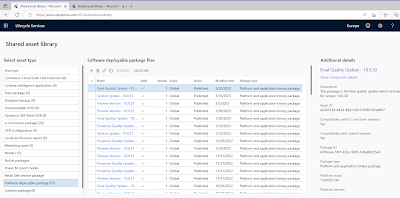Yes AX2012, back to the past :)
I just tried to start an old AOS with a new empty database.
First thing that popped up was the error code 110. So what to do?
Checking the new database I noticed that the two stored procedures CREATESERVERSESSIONS and CREATUSERSESSIONS were missing.
The solution for this error code was just to create them.
USE [AX2012DB]
GO
/****** Object: StoredProcedure [dbo].[CREATESERVERSESSIONS] Script Date: 12/24/2031 11:11:11 AM ******/
SET ANSI_NULLS ON
GO
SET QUOTED_IDENTIFIER ON
GO
CREATE procedure [dbo].[CREATESERVERSESSIONS] @aosId nvarchar(50), @version int, @instanceName nvarchar(50), @recid bigint, @maxservers int, @status int, @loadbalance int, @workload int, @serverid int OUTPUT as declare @first as nvarchar(50) declare @max_val as int begin select top 1 @first = SERVERID from SYSSERVERSESSIONS WITH (UPDLOCK, READPAST) where STATUS = 0 and AOSID = @aosId and INSTANCE_NAME = @instanceName if (select count(SERVERID) from SYSSERVERSESSIONS where SERVERID IN (@first)) > 0 begin update SYSSERVERSESSIONS set AOSID = @aosId, VERSION = @version, INSTANCE_NAME = @instanceName, LOGINDATETIME = dateadd(ms, -datepart(ms,getutcdate()), getutcdate()), LASTUPDATEDATETIME = dateadd(ms, -datepart(ms,getutcdate()), getutcdate()), STATUS = @status, WORKLOAD = @workload, AOSACCOUNT = SUSER_SNAME() where SERVERID IN (@first) and ( ((select count(SERVERID) from SYSSERVERSESSIONS where STATUS = 1 and LOADBALANCE = 0) < @maxservers) OR LOADBALANCE != 0 ) if @@ROWCOUNT = 0 select @serverid = 0 else select @serverid = @first end else begin if (select count(SERVERID) from SYSSERVERSESSIONS WITH (UPDLOCK) where STATUS = 1 and LOADBALANCE = 0) >= @maxservers select @serverid = 0 else begin if (select count(SERVERID) from SYSSERVERSESSIONS) = 0 select @max_val = 1 else select @max_val = max(SERVERID)+1 from SYSSERVERSESSIONS insert into SYSSERVERSESSIONS(SERVERID, AOSID, INSTANCE_NAME, VERSION, LOGINDATETIME, LASTUPDATEDATETIME, STATUS, RECID, LOADBALANCE, WORKLOAD, AOSACCOUNT) values(@max_val, @aosId, @instanceName, @version, dateadd(ms, -datepart(ms,getutcdate()), getutcdate()), dateadd(ms, -datepart(ms,getutcdate()), getutcdate()), @status, @recid, @loadbalance, @workload, SUSER_SNAME()) select @serverid = @max_val end end end
GO
CREATE procedure [dbo].[CREATEUSERSESSIONS] @clientType int, @sessionType int, @serverid int, @versionid int, @userid nvarchar(8), @lanExt nvarchar(10), @manExt nvarchar(10), @computerName nvarchar(80), @sid nvarchar(124), @recid bigint, @startId int, @maxusers int, @licenseType int, @masterId int, @maxClientId int, @dataPartition nvarchar(8), @sessionid int OUTPUT, @loginDateTime datetime OUTPUT as declare @return_val as int declare @first as int declare @max_val as int declare @counter as int begin select @sessionid = -1 select @max_val = -1 select @counter = 0 select @loginDateTime = dateadd(ms, -datepart(ms,getutcdate()), getutcdate()) if(not exists(select * from SYSSERVERSESSIONS WITH (NOLOCK) where SERVERID = @serverid AND Status = 1)) begin select @sessionid = -2 return end select @first = min(SESSIONID) from SYSCLIENTSESSIONS WITH (UPDLOCK,READPAST) where STATUS = 0 and SESSIONID > @maxClientId and SESSIONID <> @masterId if (select count(*) from SYSCLIENTSESSIONS where SESSIONID IN (@first)) > 0 begin if (@licenseType = 0) begin update SYSCLIENTSESSIONS set STATUS = 1, VERSION = @versionid, SERVERID = @serverid, USERID = @userid, LOGINDATETIME = @loginDateTime, SID = @sid, USERLANGUAGE = @lanExt, HELPLANGUAGE = @manExt, CLIENTTYPE = @clientType, SESSIONTYPE = @sessionType, CLIENTCOMPUTER = @computerName, DATAPARTITION = @dataPartition where SESSIONID IN (@first) end else if (@licenseType = 1) begin update SYSCLIENTSESSIONS set STATUS = 1, VERSION = @versionid, SERVERID = @serverid, USERID = @userid, LOGINDATETIME = @loginDateTime, SID = @sid, USERLANGUAGE = @lanExt, HELPLANGUAGE = @manExt, CLIENTTYPE = @clientType, SESSIONTYPE = @sessionType, CLIENTCOMPUTER = @computerName, DATAPARTITION = @dataPartition where SESSIONID IN (@first) and ((select count(SESSIONID) from SYSCLIENTSESSIONS where CLIENTTYPE = @clientType and ((STATUS = 1) or (STATUS = 2))) < @maxusers) end else if (@licenseType = 2) begin update SYSCLIENTSESSIONS set STATUS = 1, VERSION = @versionid, SERVERID = @serverid, USERID = @userid, LOGINDATETIME = @loginDateTime, SID = @sid, USERLANGUAGE = @lanExt, HELPLANGUAGE = @manExt, CLIENTTYPE = @clientType, SESSIONTYPE = @sessionType, CLIENTCOMPUTER = @computerName, DATAPARTITION = @dataPartition where SESSIONID IN (@first) and ( (select count(SESSIONID) from SYSCLIENTSESSIONS where CLIENTTYPE = @clientType and (USERID = @userid) and ((STATUS = 1) or (STATUS = 2))) > 0 or (select count(distinct USERID) from SYSCLIENTSESSIONS where CLIENTTYPE = @clientType and ((STATUS = 1) or (STATUS = 2))) < @maxusers ) end if @@ROWCOUNT = 0 select @sessionid = 0 else select @sessionid = @first end else begin if (@licenseType = 1) begin if (select count(SESSIONID) from SYSCLIENTSESSIONS where CLIENTTYPE = @clientType and ((STATUS = 1) or (STATUS = 2))) >= @maxusers select @sessionid = 0 end else if (@licenseType = 2) begin if ( ((select count(distinct USERID) from SYSCLIENTSESSIONS where CLIENTTYPE = @clientType and ((STATUS = 1) or (STATUS = 2))) >= @maxusers) and ((select count(SESSIONID) from SYSCLIENTSESSIONS where CLIENTTYPE = @clientType and (USERID = @userid) and ((STATUS = 1) or (STATUS = 2))) = 0) ) select @sessionid = 0 end if (@sessionid = -1) or (@licenseType = 0) begin while (@sessionid = -1 and @counter < 5) begin set @counter = @counter + 1 if (select count(SESSIONID) from SYSCLIENTSESSIONS WITH (UPDLOCK) where STATUS = 0 or STATUS = 1 or STATUS = 2 or STATUS = 3) = 0 select @max_val = @startId else select @max_val = max(SESSIONID)+1 from SYSCLIENTSESSIONS WITH (UPDLOCK) if (@max_val > 65535) select @sessionid = -3 else begin insert into SYSCLIENTSESSIONS(SESSIONID, SERVERID, VERSION, LOGINDATETIME, USERID, SID, USERLANGUAGE, HELPLANGUAGE, CLIENTTYPE, SESSIONTYPE, RECID, CLIENTCOMPUTER, STATUS, DATAPARTITION) values(@max_val, @serverid, @versionid, @loginDateTime, @userid, @sid, @lanExt, @manExt, @clientType, @sessionType, @recid, @computerName, 1, @dataPartition) if @@ROWCOUNT = 0 begin select @sessionid = -1 end else select @sessionid = @max_val end end end end end
GO








